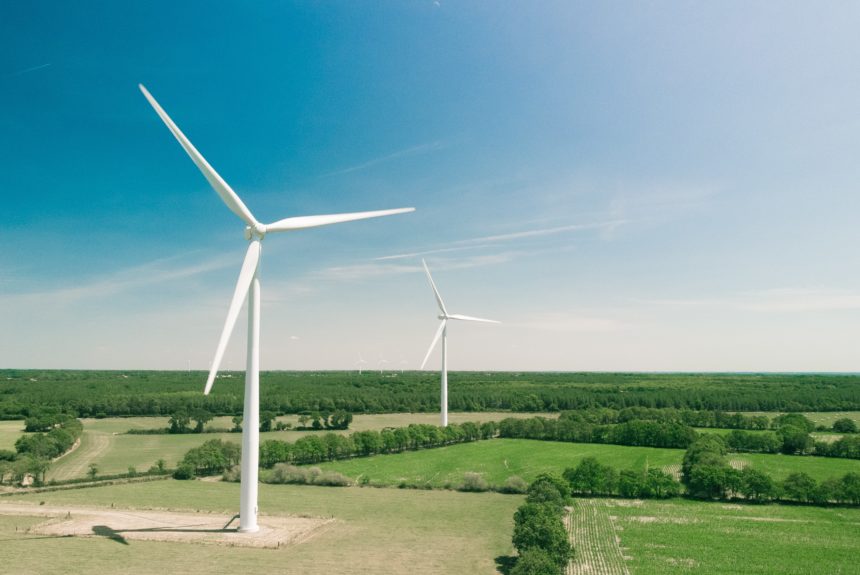What do you do with 120-foot-long wind turbine blades when they need replacing?
The aging of wind turbine blades is an increasingly important issue as many windmills begin to reach the end of their lifespan. According to the University of Strathclyde research, global turbine waste in the United Kingdom will increase five times from 400,000 tonnes per year in 2030 to 2 million tonnes per year by 2050.
Until now, the answer has been to send them to landfills, incinerate them to create energy, or grind them down for building materials. However, since the material that makes up a blade consists mainly of reinforced plastic and glass fiber – known collectively as Glass Reinforced Plastic, or GRP – almost none of the materials used to construct turbine blades are biodegradable.
Attempts to make blade disposal more sustainable and encourage a circular economy have resulted in considerable innovation. Industry is now finding new ways of recycling and separating the various components within the blades. As Harrison O’Hara, Innovation Manager for the Skanska Costain Strabag consortium, points out, “Wind turbine blades are extremely difficult to recycle. Ideas of what to do with them range from turning them into playground slides to processing them into pellets for glues and paints.”
A U.S./Irish project is exploring ways to use the blades to replace steel in construction projects. The Re-Wind project comprises researchers from the City University of New York, Georgia Institute of Technology, Cork University College, and Queen’s University Belfast. Work is underway to build a pedestrian bridge in Cork using blades as the main structural element while creating an aesthetically attractive, curved design feature. Re-wind is also investigating using blades to create electrical transmission towers, highway noise barriers, and coastal wake breaks to reduce erosion. The sheer strength of the turbine blades makes them ideal for such purposes.
Skanska Costain Strabag has taken a similar construction-based approach concerning the U.K. high-speed rail link between London and Birmingham. After being cut into sections, the blades can replace steel when reinforcing concrete for access roads and sections of wall. As an added benefit, the system reduces the project’s carbon emissions by up to 90%. Rob Cairns, innovation manager at HS2 Ltd., says, “if our world-first pilot project goes well, we could see a waste product from the energy industry becoming an essential material for the construction sector in the future.”
In the United States, GE Renewable Energy has just linked up with Veolia North America in an innovative program shredding used blades for use in the cement industry. The shredded blade pieces replace non-sustainable materials such as coal, sand, and clay, creating a net positive environmental impact and reducing carbon dioxide emissions from cement manufacture by 27%.
In Europe, innovative ways of separating wind blade components are being invented quite often.
Working with Vestas, the Danish Technological Institute, Aarhus University, has devised a 2-step process creating a circularity pathway for epoxy resin. The thermoset composite material used in the blades is broken down into glass fiber and epoxy resin. It is then put through a novel chemcycling process that breaks down the epoxy into base components. Blade-makers can then use these materials can then be used in the construction of new blades, thus creating an actual recycling system for the blades.
Equally innovative, Norway-based Aker Horizons, part of Aker Offshore Wind, has linked up with the University of Strathclyde in the U.K. to create a method by which manufacturers can recycle glass fiber. Mats Ektvedt of Akers Horizons states, “we start with end-of-life GRP waste, which is then sorted and moved through the University of Strathclyde recovery process, ending up with re-useable glass fiber for new products. The technology developed at Strathclyde is one of the most advanced recycling technologies using pyrolysis processes. The recovered glass fiber has near virgin quality and can be reused in a wide range of different new composite products.”
The consequences of such research and innovation are set to have a significant industrial impact.
“GRP scrap is a challenge not only for the wind power industry but for all industries reliant on GRP materials in their production and manufacturing,” said Ektvedt. “This includes car manufacturing, maritime vessels, oil and gas production, sporting goods, and more. Our focus now is on the recycling of wind turbine blades, but our goal is to develop recovery processes robust enough to handle other kinds of GRP waste. Going forward, we will use our competence in the industrialization of novel technologies and bring this process to an industrial scale.”
Angela Youngman is a long established freelance journalist and author based in the UK specialising in business, sustainability, travel, tourism, leisure, food & drink.
The views and opinions expressed are those of the author’s and do not necessarily reflect the official policy or position of C3.
